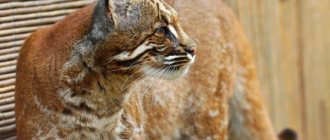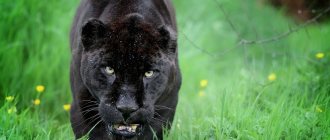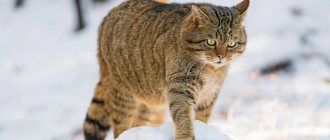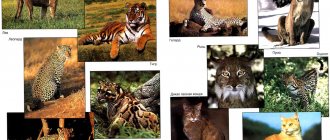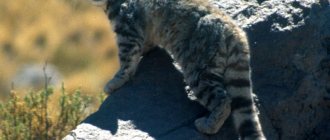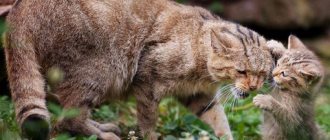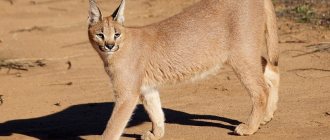- Wild animals
- >>
- Mammals
Mountain Lion - This cat has more names than any other mammal. But no matter what you call it, it’s the same cat, Puma concolor, the largest representative of small cat species. Why does he have so many names? Mainly because it has such a large habitat and people from different countries call it by their own name.
Origin of the species and description
Photo: Mountain Lion
The mountain lion is a large, graceful cat belonging to the cat family. They are also called cougars, panthers and pumas. Although mountain lions are big cats, they are not classified under the "big cat" category. Instead, they are one of the largest cats in the "small cat" category, although some can match the size of a leopard.
Video: Mountain Lion
One of the most obvious reasons why this large and powerful feline is not classified as one of the "big" cats in the world is that the mountain lion cannot roar. Mountain lions' powerful hind legs are so muscular that they not only allow them to pounce on their prey and ensure their safety, but are also capable of jumping great distances.
One of the most famous subspecies of cougar is the Florida Panther, which is the smallest of the cougar species, as well as the rarest. Considered critically endangered, this endangered animal has a more reddish tint to its fur on its back along with a dark spot in the center.
Fun fact: The scientific name Puma concolor is a little confusing because it's not entirely accurate. Concolor means "of one color," but this is not entirely true: young mountain lions are indeed one color, while adults have a mixture of shades, with an overall hue ranging from gray to rust.
Cougar conservation
The Florida cougar species has been on the verge of extinction in recent decades. According to some reports, their number in the mountainous regions is about 80 animals, but some scientists consider the inhabitant of the eastern states of the United States to be extinct. Listed in the Red Book.
The reason for the death of the American mountain lion population is said to be the drainage of swamps for the development of new lands, passion for sport hunting, inbreeding and extinction of the species due to inbreeding.
Another species of American cougar, the Wisconsin cougar, became extinct back in 1925; its representatives could not be saved.
Appearance and features
Photo: What a mountain lion looks like
Mountain lions have similar body types to domestic cats, just on a larger scale. They have slender bodies and round heads with pointed ears. They vary between 1.5-2.7 m from head to tail. While males can weigh up to 68 kg, females weigh less, peaking at around 45 kg.
Mountain lions are well built, have large paws and sharp claws. Their hind legs are larger and more muscular than their front legs, giving them greater jumping power. Mountain lions can leap 5.5 meters from the ground into trees, and are capable of jumping 6.1 meters up or down a hill, which is the height of many two-story buildings. Mountain lions are also capable of running fast and have a flexible spine like a cheetah, which helps them move around obstacles and change direction quickly.
The mountain lion's coat is grayish-brown to slightly reddish in color with lighter areas on the underside. The tail has a black spot at the end. The muzzle and chest are white, with black markings on the face, ears and tip of the tail. Mountain lion kittens have black spots until they are about 6 months old.
Geographically and seasonally, the shade of brown varies from gray to reddish brown, and some black cougars have been reported. The color patterns on the face can also vary. The underside is lighter than the top. The long tail is often colored black and is usually held close to the ground when the mountain lion walks.
The lower jaw is short, deep and powerful. The carnassial teeth are massive and long. The fangs are heavy and compressed. The incisors are small and straight. Mountain lions have another small premolar on each side of the upper jaw, unlike bobcats.
Fun fact: Mountain lion tracks are made by four toes on the front paw and four toes on the back paw. Retractable claws do not appear on prints.
Description of the puma
Puma concolor is the name of the species in Latin, where the second part is translated as “one-color”, and this statement is true if we evaluate color in terms of the absence of a pattern. On the other hand, the animal does not look entirely monochrome: the upper part contrasts with the light belly, and the white zone of the chin and mouth is clearly visible on the muzzle.
Appearance
An adult male is about a third larger than a female and weighs 60–80 kg with a length of 1–1.8 meters . Some specimens gain 100–105 kg. The puma's height is 0.6–0.9 m, and its muscular, evenly pubescent tail is 0.6–0.75 m. The cougar has an elongated and flexible body, crowned with a proportional head with rounded ears. The puma has a very attentive gaze and beautiful eyes outlined in black. The color of the iris varies from hazel and light gray to green.
The hind paws are wide (with 4 toes) more massive than the front paws, which have 5 toes. The fingers are armed with curved and sharp claws that retract, like all cats. Retractable claws are needed for capturing and holding prey, as well as for climbing trunks. The mountain lion's fur is short, coarse, but thick, reminiscent of the coloring of its main prey - deer. In adults, the underside of the body is much lighter than the top.
This is interesting! The predominant shades are red, gray-brown, sand and yellowish-brown. White markings are visible on the neck, chest and belly.
The cubs are colored differently: their dense fur is dotted with dark, almost black spots, there are stripes on the front and hind limbs, and rings on the tail. Climate also affects the coloration of pumas. Those who live in tropical regions give off reddish hair, while those who live in northern regions tend to show gray tones.
Puma subspecies
Until 1999, biologists worked with the old classification of cougars, based on their morphological characteristics and distinguishing almost 30 subspecies. Modern classification (based on genetic research) has simplified the calculation, reducing the entire diversity of pumas to just 6 subspecies, included in the same number of phylogeographic groups.
Simply put, predators differ both in their genomes and in their attachment to a specific territory:
- Puma concolor costaricensis – Central America;
- Puma concolor couguar – North America;
- Puma concolor cabrerae - central South America;
- Puma concolor capricornensis – eastern South America;
- Puma concolor puma – southern part of South America;
- Puma concolor concolor - northern part of South America.
This is interesting! The rarest subspecies is Puma concolor coryi, the Florida cougar, living in the forests/swamps of South Florida.
The highest concentration was observed in the Big Cypress National Preserve (USA) . In 2011, a little more than 160 individuals lived here, which is why the subspecies was listed in the IUCN Red List with the status “critically endangered” (in critical condition). The disappearance of the Florida cougar, according to biologists, is to blame for the man who drained the swamps and hunted it for sport. Inbreeding also contributed to the extinction, when closely related animals mated (due to the small population).
Lifestyle, character
Cougars are principled loners who come together only during the mating season and then for no more than a week. Females with kittens also stay together. Adult males are not friends: this is typical only for young pumas that have recently separated from their mother’s hem. The population density is influenced by the presence of game: a single cougar can rule over 85 km², and more than a dozen predators can rule over half the area.
As a rule, the female’s hunting plot occupies from 26 to 350 km², adjacent to the male’s plot. The sector where the male hunts is wider (140–760 km²) and never intersects with the territory of the opponent. Lines are marked using urine/feces and scratches on trees. The puma changes its location within the area depending on the time of year. Mountain lions are well adapted to life in rough terrain: they are excellent jumpers (the best of all cats) both in length and height.
Puma records:
- long jump – 7.5 m;
- high jump – 4.5 m;
- jump from a height of 18 m (like from the roof of a five-story building).
This is interesting! The cougar accelerates to 50 km/h, but quickly runs out of steam, but it easily overcomes mountain slopes and climbs rocks and trees very well. Pumas running from dogs in the southwestern deserts of the United States have even climbed giant cacti. The animal is also a good swimmer, but does not show much interest in this sport.
The puma hunts at dusk, preferring to knock down its prey with one powerful leap, and during the day the predator sleeps in its den, basks in the sun or licks itself, like all cats. For a long time there were stories about the chilling howl made by the puma, but everything turned out to be fiction. The loudest screams occur during the rutting period, and the rest of the time the animal is limited to growling, rumbling, hissing, snorting and the usual cat “meow”.
Lifespan
In the wild, pumas live to be 18–20 years old unless they are caught by a hunting rifle or caught by a larger animal.
Return to content
Where does the mountain lion live?
Photo: American mountain lion
The mountain lion is believed to be one of the most adaptable felines, as they are found in a variety of habitats. However, with the expansion of human settlements and the clearing of land for agriculture, the mountain lion is being pushed into smaller pockets of its historically large territory, retreating into a more hostile mountain environment that is further away from people. There are six subspecies of mountain lions, distributed in areas such as:
- South and Central America;
- Mexico;
- Western and North America;
- Florida.
Mountain lions tend to roam in areas where they would not be seen, such as rocky mountains or dark forests. They usually do not attack people unless they feel cornered or threatened. Most of the mountain lion population can be found in western Canada, but it has also been spotted in southern Ontario, Quebec and New Brunswick. Mountain lions are important as top predators in the ecosystems in which they live. They help control populations of large ungulates.
Although mountain lion attacks on humans are extremely rare, they have been on the rise in the last few decades. As with most livestock killings, a mountain lion that attacks a human is usually a starved animal that has been pushed into marginal habitat by more dominant males.
But it is human encroachment into mountain lion territory that creates marginal mountain lion habitat. The more people vacation and live in rural areas, the higher the likelihood of encountering these secretive animals. However, by taking some precautions, humans and mountain lions can coexist.
Now you know where the mountain lion is. Let's see what this wild cat eats.
Habitat
These cats boast the most extensive habitat. They inhabit the North American continent, are found in Central American countries, and are found in almost all regions of South America.
Cougars inhabit most countries of both American continents
The natural habitat of pumas extends from the southern regions of Canada to the Rocky Mountains of the United States. They are found in northeastern Mexico, Nicaragua, Costa Rica, Guatemala and Panama. On the South American continent, pumas live in areas ranging from northern latitudes to the pampas of Patagonia.
Pumas have an amazing ability to adapt to any living conditions with different landscapes. They live in cold coniferous forests and in the hot tropics. They live in wetlands and grassy plains. Cougars can be found in the high mountain regions of the United States and Canada, and in the arid South American pampas.
What does a mountain lion eat?
Photo: Mountain lion from the Red Book
Mountain lions hunt over a large area, and it can take one member of the species a week to roam an entire home. Mountain lions eat different prey depending on where they live. Basically, a mountain lion will eat any animal it can catch, even ones as big as elk.
Their food can be:
- deer;
- pigs;
- capybaras;
- raccoons;
- armadillos;
- hares;
- proteins.
Mountain lions love to hunt deer, although they also eat smaller animals such as coyotes, porcupines and raccoons. They usually hunt at night or during the dark hours of dawn and dusk. These cats use a mixture of stealth and strength to hunt. A mountain lion will stalk its prey through bushes and trees and over rock ledges before powerfully leaping onto the victim's back and delivering a suffocating bite to the neck. The puma's flexible spine is adapted for this killing technique.
When large prey dies, the mountain lion is known to cover it with bushes and return to feed within a few days. They subsidize their diets with large insects and small rodents. Annual food consumption ranges from 860 to 1,300 kg of large carnivores, about 48 ungulates per mountain lion per year.
Fun Fact: Mountain lions have particularly keen eyesight and are most likely to locate prey by watching it move. These cats hunt most actively at dusk or dawn.
Who do cougars hunt?
The diet of these cats is directly related to their place of residence, but the diet of all subspecies of pumas is based on large herbivores, such as:
- Red and pampas deer, elk, caribou;
- Bighorn sheep (American wild sheep), mountain goats;
- Vicunas, guanacos, alpacas, llamas;
- Pronghorn antelope;
- Peccaries (musk pigs);
- Capybaras;
- Rhea ostriches.
Cougars do not disdain smaller prey, and the list of their victims includes:
- Monkey;
- Raccoons, otters, beavers;
- Rabbits, hares, opossums, mice;
- American badgers and minks;
- Muskrats, squirrels;
- Armadillos;
- Wild Turkeys;
- Reptiles, fish, snails and insects.
Pumas inhabiting the Canadian province of Columbia often prey on sea lions, and penguins are the favorite food of Patagonian mountain cats. In Costa Rica and Chile, these predators hunt eared seals. And cougars living in South America even engage in fights with caimans, from which they most often emerge victorious.
Unfortunately, not only wild inhabitants of forests and pampas fall into the clutches of pumas. They hunt and hunt livestock, killing goats, sheep and even dogs and cats. It is for this reason that American farmers do not like cougars so much, and do not hesitate to shoot the adorable cats that dare to approach human settlements.
Mountain lion hunting method
Although cougars are very strong and resilient, they cannot compete in long races with agile deer and goats. Therefore, the cougar’s favorite hunting technique is waiting in ambush. Most often, the puma takes refuge in a tree or rocky cliff, blending into the background thanks to its sandy-reddish color, and patiently waits for its future victim. As soon as a careless animal approaches the predator's ambush, the cat overtakes the prey with a lightning-fast jump, breaking its spine with its weight, or suffocates it, clinging its teeth to the throat.
Impressive puma jump
In 85% of cases, puma hunting is successful. But if the victim managed to escape from the formidable cougar, he will not pursue her, but will return to his hiding place and wait for the next prey.
The puma drags the carcass of the killed animal to a secluded place, where, hidden from prying eyes, it can have lunch in peace. If a cat's trophy is a deer or elk, she buries the remains of the meal in the snow or throws leaves and branches in order to eat it later. Large prey for a cougar can be enough to feed for 2-3 days. But their “larder” is often ravaged by small predators, such as coyotes, lynxes and ocelots.
Puma growl
Features of character and lifestyle
Photo: Mountain lion in winter
Mountain lions are territorial animals, and territory depends on terrain, vegetation, and the abundance of prey. Mountain lions avoid areas where there are human settlements. Women's territories tend to be half of men's territories.
Mountain lions are most active at dawn and dusk. Mountain lions are ambush predators, meaning they depend on stealth and the element of surprise to catch their prey—primarily deer and elk, sometimes porcupine or elk, and sometimes smaller species like raccoons. rabbits, beavers or even mice.
They inhabit large areas, which are usually oval or round in shape. The area of intimidating territories and their numbers depend on the abundance of prey, vegetation and terrain. If there is a shortage of production in a particular area, the size of individual territories will be large. They do not have permanent dens, but are found in caves, rocky outcrops, and dense vegetation. Mountain lions tend to migrate to the mountains during the winter, primarily for hunting purposes.
Mountain lions are vocal cats that are well known for their low hisses, growls, purrs and calls. Because they have the largest hind legs in the cat family, mountain lions can jump very high - up to 5.4 meters. Horizontal jumps can measure from 6 to 12 meters. They are very fast cats and are also good climbers and can swim.
Mountain lions rely primarily on sight, smell, and hearing. They use low hisses, growls, purrs and screams in a variety of circumstances. Loud, whistling sounds are used to call the mother. Touch is important in the social bond between mother and calf. Scent marking is important within the boundaries of territory designation and reproductive state.
Social structure and reproduction
Photo: Mountain lion in nature
A mountain lion in the wild will not mate until it has established a home territory. Mountain lions begin breeding at around 3 years of age. Like many other felines, mountain lion cubs are born blind and completely helpless for the first two weeks of life until their blue eyes open fully.
The cubs are separated from their mother after 2-3 months. Newborn mountain lions have spots that help them blend in with the grass and dappled sunlight. Their eyes also change from blue to yellow by the time they are 16 months old.
By 18 months, young cats leave their mother to fend for themselves. Their mother feeds them for about 3 months, but they begin to eat meat at about 6 weeks. At 6 months, their spots begin to fade and they are trained to hunt. The cubs live with their mother for up to 12-18 months.
Mountain lion cubs are more vicious than the cubs and kittens of many other cats - they are untamable from birth, and all attempts to befriend a mountain lion seem to have failed. Mountain lions are wild animals in an unusual sense, and they apparently cannot be domesticated to any degree.
Mountain lions breed year-round, but breeding season typically occurs between December and March. Female mountain lions typically give birth every two years. In the wild, a mountain lion can live up to 10 years. In captivity they can live up to 21 years.
Captivity
Keeping cougars in private zoos or homes has become fashionable over the past decades. However, people who decide to keep a predatory animal should be aware of its freedom-loving character. Close contact with a cougar poses a danger to humans.
Life in zoos is quite comfortable for cougars; they quickly get used to it. They live longer in captivity than in the wild due to the lack of threat from enemies and diseases. Females safely bear and raise offspring. Many species of mountain lions have been saved from extinction in this way, and their numbers have been restored thanks to human care.
Mountain lion: photo and description, habitat, reproduction and nutrition on News4Auto.ru.
Our life consists of everyday little things that in one way or another affect our well-being, mood and productivity. I didn’t get enough sleep - my head hurts; I drank coffee to improve the situation and cheer myself up - I became irritable. I really want to foresee everything, but I just can’t. Moreover, everyone around, as usual, gives advice: gluten in bread - don’t go near it, it will kill you; A chocolate bar in your pocket is a direct path to tooth loss. We collect the most popular questions about health, nutrition, diseases and give answers to them that will allow you to better understand what is good for your health.
Natural enemies of mountain lions
Photo: Mountain Lion in America
For the most part, the mountain lion has no natural predators and is at the top of the food chain. However, they sometimes compete with other predators such as bears and wolves for food. Wolves pose a real threat to mountain lions, either directly or indirectly. Wolves rarely eat kittens that they kill, suggesting that they kill to eliminate competition. And while the wolves haven't killed the adult mountain lions, they seem to stalk them at every opportunity.
The biggest threat to the mountain lion is habitat loss. As people move deeper into its habitat, not only for housing and ranching but also for recreational activities, mountain lions have difficulty establishing enough hunting territories without risking encounters with humans. This is when this predator becomes prey for trophy hunting, livestock protection and the general safety of pets and sometimes children.
The most significant cause of mortality for mountain lions is hunting, which accounts for nearly half of adult deaths. The first mountain lion hunting season was established in 2005 as an “experimental season,” and the season continues to be used as a tool to manage mountain lion populations at desired levels.
Population and species status
Photo: What a mountain lion looks like
Currently, mountain lions are primarily found west of 100°W (roughly central Texas to Saskatchewan), with the exception of southern Texas. Information about Central and South America is lacking, although it is believed that the habitats most suitable for mountain lions exist there.
While there is no exact estimate for the global mountain lion population, it is believed that there are approximately 30,000 individuals in the American West. Densities can range from 1-7 mountain lions per 100 km2, with males carrying multiple females within their home range.
Today, white-tailed deer populations have recovered across much of the cougar's former range, with several animals appearing in more eastern states such as Missouri and Arkansas. Some biologists believe these big cats could eventually reclaim much of the Midwest and East—if people let them. In most western US states and Canadian provinces, the population is considered stable enough to support sport hunting.
Mountain lions are classified as "endangered." The total breeding population of mountain lions is less than 50,000 and continues to decline. They have no particular threats from animals other than humans, although they do interact with other large predators, such as the brown bear and gray wolf, with whom they compete for prey. When the range of mountain lions and jaguars overlaps, the jaguars will dominate larger prey and the mountain lion will take smaller prey.
